Minutes of the Federal Open Market Committee
April 24-25, 2012
In conjunction with the April 24-25, 2012, Federal Open Market Committee (FOMC) meeting, meeting participants--the members of the Board of Governors and the presidents of the Federal Reserve Banks, all of whom participate in the deliberations of the FOMC--submitted their assessments of real output growth, the unemployment rate, inflation, and the target federal funds rate for each year from 2012 through 2014 and over the longer run, under each participant's judgment of appropriate monetary policy. These assessments were based on information available at the time of the meeting and participants' individual assumptions about factors likely to affect economic outcomes. The longer-run projections represent each participant's assessment of the rate to which each variable would be expected to converge, over time, under appropriate monetary policy and in the absence of further shocks to the economy. "Appropriate monetary policy" is defined as the future path of policy that participants deem most likely to foster outcomes for economic activity and inflation that best satisfy their individual interpretations of the Federal Reserve's objectives of maximum employment and stable prices.
Overall, the assessments that FOMC participants submitted in April indicated that, with appropriate monetary policy, the pace of economic recovery over the 2012-14 period would likely continue to be moderate. As depicted in figure 1, participants judged that real gross domestic product (GDP) would rise this year at a rate that slightly exceeds their estimates of its longer-run sustainable rate of increase, and then accelerate gradually through 2014. Taking into account the decline in the unemployment rate since the time of the previous Summary of Economic Projections (SEP) in January, participants generally anticipated only a small further reduction in the unemployment rate this year. They judged that the unemployment rate would then gradually move lower as economic growth picks up. Even so, participants generally projected that the unemployment rate at the end of 2014 would still be well above their estimates of the longer-run rate of unemployment that they currently view as being consistent with the FOMC's statutory mandate for promoting maximum employment and price stability. Most participants judged that inflation, as measured by the annual change in the price index for personal consumption expenditures (PCE), would be at or below the FOMC's long-run inflation objective of 2 percent under the assumption of appropriate monetary policy. Core inflation was generally projected to run at rates similar to those of overall inflation.
Relative to their previous projections in January, shown in table 1, participants revised up their projected rate of increase in real GDP in 2012 while marking down the pace of real growth over the next two years. With the unemployment rate having declined in recent months by more than participants had anticipated in the previous SEP, they generally lowered their projections for the level of the unemployment rate over coming years. Participants' expectations for both the longer-run rate of increase in real GDP and the longer-run unemployment rate were little changed from January. Their projection for the rate of inflation in 2012 moved up since January, reportedly in light of the recent increases in the prices of crude oil and gasoline, with much smaller increases in their projections for 2013 and 2014. The range and central tendency of the projections of longer-run inflation remained equal to 2 percent.
Table 1. Economic projections of Federal Reserve Board members and Federal Reserve Bank presidents, April 2012
Percent
| Variable | Central tendency1 | Range2 | ||||||
|---|---|---|---|---|---|---|---|---|
| 2012 | 2013 | 2014 | Longer run | 2012 | 2013 | 2014 | Longer run | |
| Change in real GDP | 2.4 to 2.9 | 2.7 to 3.1 | 3.1 to 3.6 | 2.3 to 2.6 | 2.1 to 3.0 | 2.4 to 3.8 | 2.9 to 4.3 | 2.2 to 3.0 |
| January projection | 2.2 to 2.7 | 2.8 to 3.2 | 3.3 to 4.0 | 2.3 to 2.6 | 2.1 to 3.0 | 2.4 to 3.8 | 2.8 to 4.3 | 2.2 to 3.0 |
| Unemployment rate | 7.8 to 8.0 | 7.3 to 7.7 | 6.7 to 7.4 | 5.2 to 6.0 | 7.8 to 8.6 | 7.0 to 8.1 | 6.3 to 7.7 | 4.9 to 6.0 |
| January projection | 8.2 to 8.5 | 7.4 to 8.1 | 6.7 to 7.6 | 5.2 to 6.0 | 7.8 to 8.6 | 7.0 to 8.2 | 6.3 to 7.7 | 5.0 to 6.0 |
| PCE inflation | 1.9 to 2.0 | 1.6 to 2.0 | 1.7 to 2.0 | 2.0 | 1.8 to 2.3 | 1.5 to 2.1 | 1.5 to 2.2 | 2.0 |
| January projection | 1.4 to 1.8 | 1.4 to 2.0 | 1.6 to 2.0 | 2.0 | 1.3 to 2.5 | 1.4 to 2.3 | 1.5 to 2.1 | 2.0 |
| Core PCE inflation3 | 1.8 to 2.0 | 1.7 to 2.0 | 1.8 to 2.0 | 1.7 to 2.0 | 1.6 to 2.1 | 1.7 to 2.2 | ||
| January projection | 1.5 to 1.8 | 1.5 to 2.0 | 1.6 to 2.0 | 1.3 to 2.0 | 1.4 to 2.0 | 1.4 to 2.0 | ||
1. The central tendency excludes the three highest and three lowest projections for each variable in each year. Return to table
2. The range for a variable in a given year consists of all participants' projections, from lowest to highest, for that variable in that year. Return to table
3. Longer-run projections for core PCE inflation are not collected. Return to table
As shown in figure 2, most participants judged that highly accommodative monetary policy was likely to be warranted over coming years to promote a stronger economic recovery in the context of price stability. In particular, with inflation generally projected to be subdued over the projection period and the unemployment rate elevated, 11 participants thought that it would be appropriate for the first increase in the target federal funds rate to occur during 2014 or later, the same number as in the January SEP (upper panel). However, in contrast to their assessments in January, none of the participants indicated that 2016 was the appropriate year to first increase the target federal funds rate. The remaining 6 participants judged that it would be appropriate to raise the federal funds rate in 2012 or 2013 in order to avoid a buildup of inflationary pressures or the creation of imbalances in the financial system. Each participant's individual assessment of the appropriate year-end level of the target federal funds rate over the projection period was substantially below his or her projection of the longer-run level of the federal funds rate (lower panel). In addition, 9 participants placed the target federal funds rate at 1 percent or lower at the end of 2014.
All participants indicated that they expected the Federal Reserve's balance sheet would be normalized in a manner consistent with the principles that the FOMC agreed on at its June 2011 meeting, with the date that participants gave for the onset of the normalization process dependent on their expected timing of the first increase in the target federal funds rate. One participant reported that appropriate policy would include additional balance sheet actions in the near term to mitigate downside risks to economic growth.
Most participants judged the level of uncertainty associated with their projections for real activity, the unemployment rate, and inflation to be unusually high relative to historical norms, although the number of participants doing so declined somewhat since the January SEP. About half of the participants now see the risks to real GDP growth as weighted to the downside and those to the unemployment rate as weighted to the upside, also down somewhat from the previous SEP. As in January, a majority of participants viewed the risks to their inflation projections as broadly balanced.
Figure 1. Central tendencies and ranges of economic projections, 2012–14 and over the longer run*
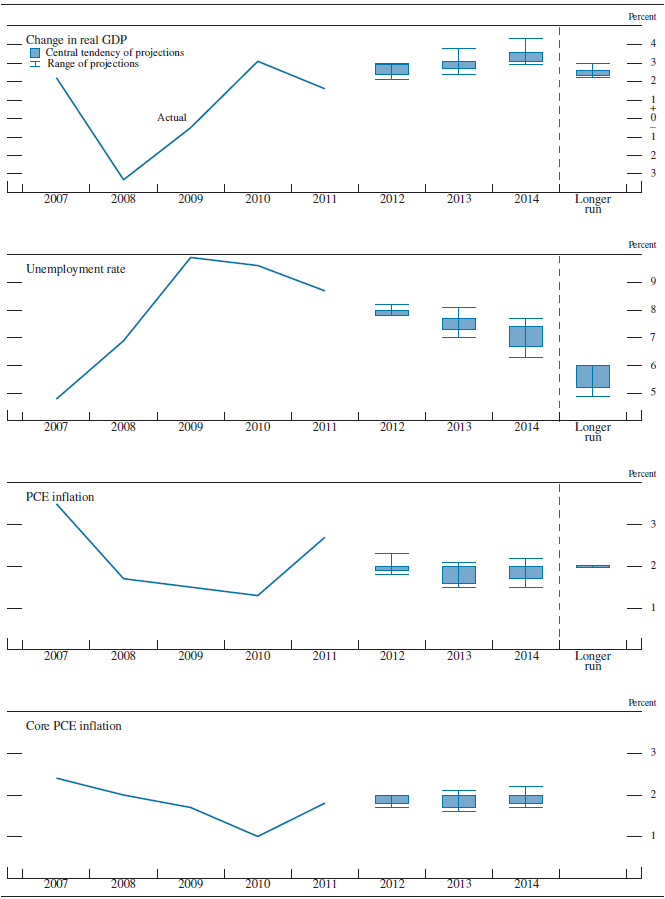
*NOTE: Definitions of variables are in the notes to table 1. The data for the actual values of the variables are annual.
Accessible version of figure 1 | Return to figure 1
The Outlook for Economic Activity
Under appropriate monetary policy, participants continued to judge that the economy would expand at a moderate pace over the projection period. The central tendency of participants' projections for the change in real GDP growth in 2012 was 2.4 to 2.9 percent, a bit higher than in January. Growth at this rate would be a noticeable pickup from the pace of expansion in 2011 and a little above most participants' assessments of trend growth over the longer run. Most participants characterized the incoming data on consumer spending--especially for motor vehicles--as being at least somewhat stronger than had been anticipated in January, and several also pointed to some encouraging signs in recent readings on housing activity. A few participants indicated they had seen some improvements in household and business confidence. Participants projected that real GDP growth would pick up gradually over the 2013–14 period. Economic growth would be supported by monetary policy accommodation as well as some gradual improvements in credit conditions, the housing sector, and household balance sheets. The central tendencies of participants' projections of real growth in 2013 and 2014 were 2.7 to 3.1 percent and 3.1 to 3.6 percent, respectively, down somewhat from the central tendencies of the January projections. The central tendency of participants' projections for the longer-run rate of increase of real GDP was 2.3 to 2.6 percent, unchanged from January.
Participants cited several factors that would likely continue to restrain the pace of economic expansion over the projection period. In particular, tighter fiscal policy seemed likely to impart a significant drag on economic activity for a time. Moreover, uncertainty about the fiscal environment could hold back both household spending on durable goods and business capital expenditures. In addition, some participants noted that the recent stronger data might reflect temporary factors. For example, the pace of consumer spending was seen as likely to fall back some and be more in line with that of disposable personal income, and federal outlays were not expected to continue at their recent pace. Moreover, a couple of participants also pointed to the unseasonably warm winter weather as a possible contributor to the more favorable tone to the recent incoming data.
Most participants marked down their projections for the rate of unemployment over the projection period. The unemployment rate had declined from 8.7 percent, on average, in the final quarter of last year to 8.2 percent at the end of the first quarter of 2012, more than most participants anticipated when they prepared their January projections. With real GDP expected to increase at a moderate pace, the unemployment rate was projected to decline only a bit further this year, with the central tendency of participants' forecasts at 7.8 to 8.0 percent at year-end. Participants projected that in 2013 and 2014, the pickup in the pace of the expansion would be accompanied by a further gradual improvement in labor market conditions. The central tendency of participants' forecasts for the unemployment rate was 7.3 to 7.7 percent at the end of 2013 and 6.7 to 7.4 percent at the end of 2014. The central tendency of participants' estimates of the longer-run normal rate of unemployment that would prevail in the absence of further shocks to the economy was 5.2 to 6.0 percent, unchanged from January. Most participants anticipated that five or six years would be required to close the gap between the current unemployment rate and their estimates of the longer-run rate, although a few anticipated that less time would be needed.
The diversity of participants' projections for real GDP growth and the unemployment rate over the next three years and over the longer run is depicted in figures 3.A and 3.B. The dispersion in these projections reflects differences in participants' assessments of many factors, including appropriate monetary policy and its effects on the economy, the underlying momentum in economic activity, the likely evolution of credit and financial market conditions, the prospective path for U.S. fiscal policy, the effects of the European situation, and the extent to which current dislocations in the labor market were structural versus cyclical. Given the decline in the rate of unemployment in the first quarter, the distribution of participants' projections of this variable for the fourth quarter of 2012 shifted noticeably lower, and the range of these projections became considerably narrower, relative to the January assessments. The distributions of the unemployment rate projections for 2013 and 2014 exhibited less pronounced shifts toward lower rates. Participants made only minor adjustments to their projections of the rates of output growth and unemployment over the longer run, leaving the dispersions of their projections for both little changed. As in January, the dispersion of estimates for the longer-run rate of output growth is fairly narrow, with only one participant's estimate outside of a range of 2.2 to 2.7 percent. By comparison, participants' views about the level to which the unemployment rate would converge in the longer run are more diverse, reflecting, among other things, different views on the outlook for labor supply and the structure of the labor market.
Figure 2. Overview of FOMC participants' assessments of appropriate monetary policy, April 2012*
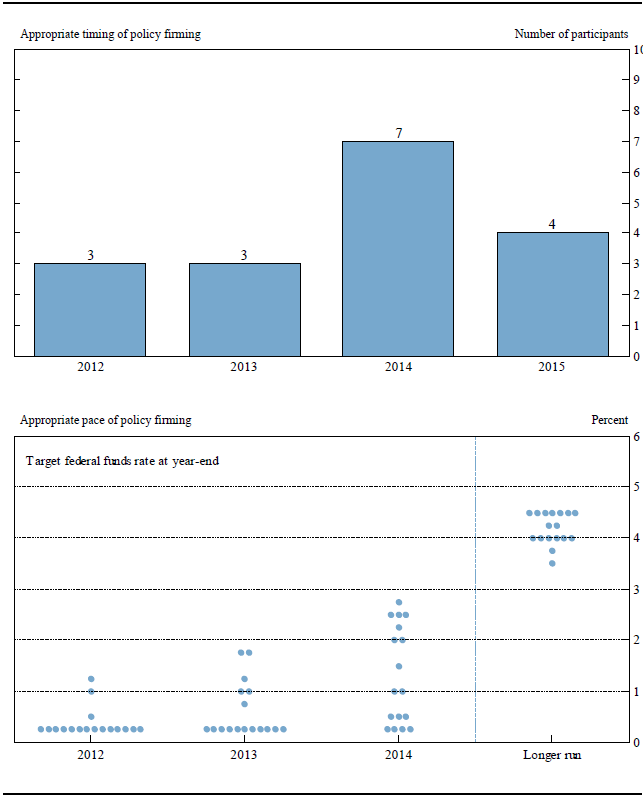
*NOTE: In the upper panel, the height of each bar denotes the number of FOMC participants who judge that, under appropriate monetary policy, the first increase in the target federal funds rate from its current range of 0 to 1/4 percent will occur in the specified calendar year. In January 2012, the numbers of FOMC participants who judged that the first increase in the target federal funds rate would occur in 2012, 2013, 2014, 2015, and 2016 were, respectively, 3, 3, 5, 4, and 2. In the lower panel, each shaded circle indicates the value (rounded to the nearest 1/4 percent) of an individual participant’s judgment of the appropriate level of the target federal funds rate at the end of the specified calendar year or over the longer run.
Accessible version of figure 2 | Return to figure 2
The Outlook for Inflation
Participants' views about the outlook for inflation generally firmed a little since January. In particular, a majority of participants indicated that the incoming readings on inflation, especially for the prices of crude oil and gasoline, were a little higher than had been anticipated. Nonetheless, assuming no further shocks, most participants judged that both headline and core inflation would remain subdued over the 2012-14 period, running at rates at or below the FOMC's longer-run objective of 2 percent under the assumption of appropriate monetary policy. Participants pointed to several factors that would help restrain inflation pressures over the projection period, including expected declines in commodity prices, modest increases in business costs, and the ongoing stability of inflation expectations. Specifically, the central tendency of participants' projections for inflation, as measured by the PCE price index, moved up in 2012 to 1.9 to 2.0 percent, and it edged up in 2013 and 2014 to 1.6 to 2.0 percent and 1.7 to 2.0 percent, respectively; the central tendencies of the forecasts for core PCE inflation were very close to those for the total measure. Participants indicated that it would take about five or six years, or less, for inflation to converge to its longer-run level.
Information about the diversity of participants' views regarding the outlook for inflation is provided in figures 3.C and 3.D. Relative to the assessments that were compiled in January and reflecting the recent incoming data, the projections for inflation shifted higher in 2012 and exhibited a noticeably narrower range. The dispersion of inflation projections also narrowed in 2013, although to a lesser degree, and was little changed in 2014. In general, the dispersion of views on the outlook for inflation over the projection period represented differences in judgments regarding a range of issues, including the current degree of slack in resource utilization and the extent to which such slack influences inflation and inflation expectations. In addition, participants differed in their estimates of how the stance of monetary policy would influence inflation expectations.
Figure 3.A. Distribution of participants' projections for the change in real GDP, 2012–14 and over the longer run*
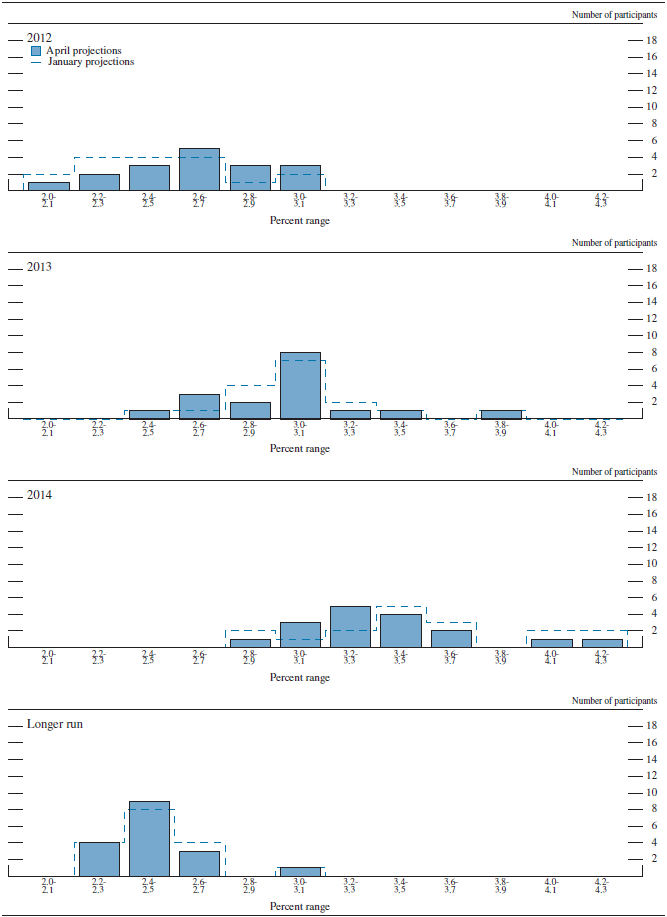
*NOTE: Definitions of variables are in the general note to table 1.
Accessible version of figure 3.A. | Return to figure 3.A.
Figure 3.B. Distribution of participants' projections for the unemployment rate, 2012–14 and over the longer run*
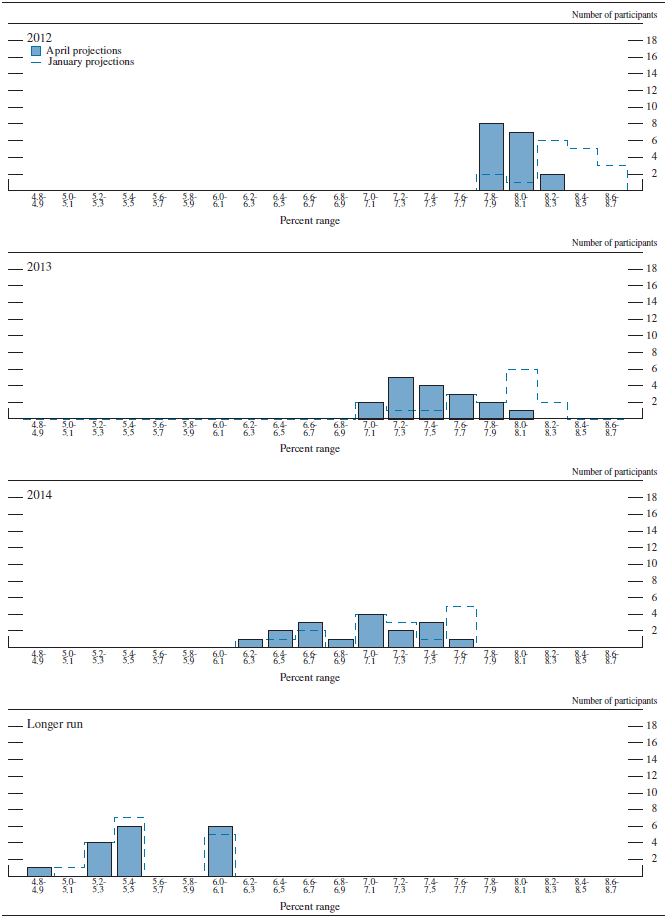
*NOTE: Definitions of variables are in the general note to table 1.
Accessible version of figure 3.B. | Return to figure 3.B.
Figure 3.C. Distribution of participants' projections for PCE inflation, 2012–14 and over the longer run*
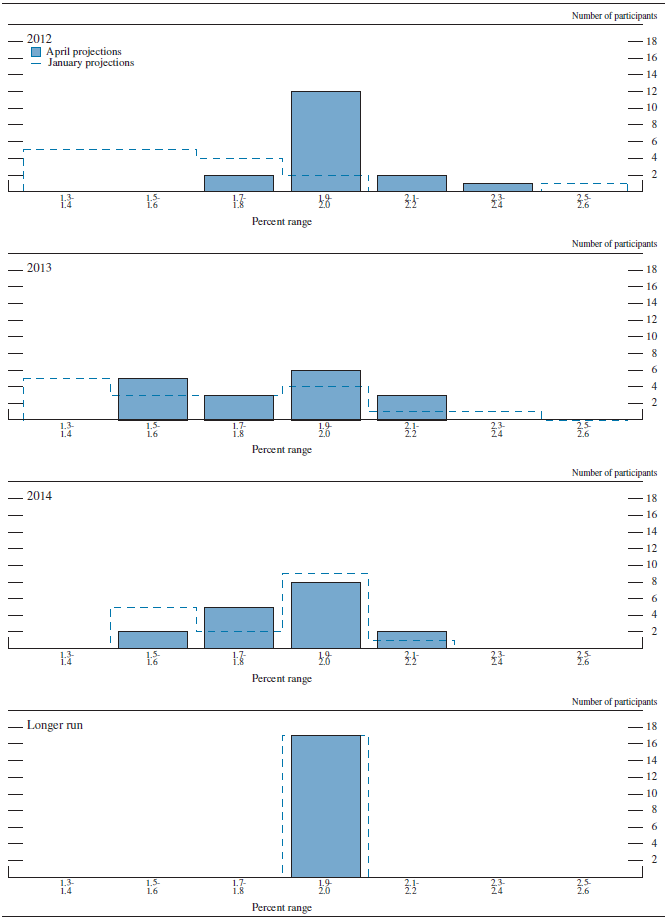
*NOTE: Definitions of variables are in the general note to table 1.
Accessible version of figure 3.C. | Return to figure 3.C.
Figure 3.D. Distribution of participants' projections for core PCE inflation, 2012–14*
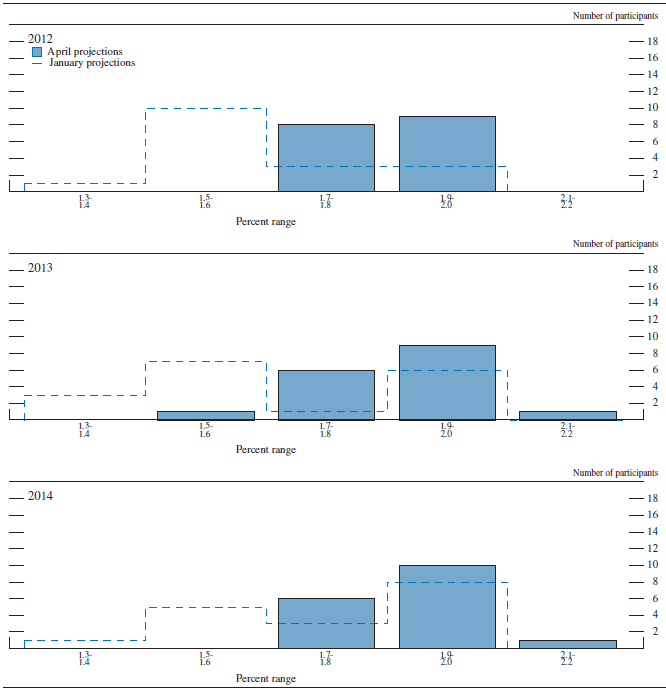
*NOTE: Definitions of variables are in the general note to table 1.
Accessible version of figure 3.D. | Return to figure 3.D.
Appropriate Monetary Policy
About half of the participants judged that exceptionally low levels of the federal funds rate would remain appropriate at least until late 2014. In particular, seven participants viewed appropriate policy firming as commencing during 2014, while four others judged that the first increase in the target federal funds rate would not be warranted until 2015. Nine participants anticipated that the appropriate federal funds rate at the end of 2014 would be 1 percent or lower. Those who saw the first increase occurring in 2015 anticipated that the federal funds rate would be either 1 percent or 1-1/2 percent at the end of that year. In contrast, six participants judged that an increase in the target federal funds rate would be appropriate in 2012 or 2013, and those participants anticipated that the target rate would need to be increased to around 2 to 2-3/4 percent by the end of 2014. All participants reported levels for the appropriate target federal funds rate at the end of 2014 that were well below their estimates of the level expected to prevail in the longer run. Participants' estimates of the longer-run target federal funds rate ranged from 3-1/2 to 4-1/2 percent, reflecting the Committee's inflation objective of 2 percent and participants' individual judgments about the longer-run equilibrium level of the real federal funds rate.
Several key factors informed participants' individual expectations about the appropriate setting for monetary policy, including their assessments of the maximum level of employment, the Committee's longer-run inflation objective, the extent to which current conditions had deviated from these mandate-consistent levels and why the deviations had arisen, and their projections of the likely time periods required to return employment and inflation to levels they judge to be most consistent with the Committee's mandate. Several participants commented that their assessments took into account the risks and uncertainties associated with their outlooks for economic activity and inflation, and one pointed specifically to the potential effects of a protracted period of very low interest rates on financial stability. Participants also noted that because the appropriate stance of monetary policy depends importantly on the evolution of real activity and inflation over time, their assessments of the appropriate future path of the federal funds rate would change if economic conditions were to evolve in an unexpected manner.
Participants also provided qualitative information on their views regarding the appropriate path of the Federal Reserve's balance sheet. All participants expect that the Committee would carry out the normalization of the balance sheet according to the principles approved at the June 2011 FOMC meeting. That is, prior to the first increase in the federal funds rate, the Committee would likely cease reinvesting some or all principal payments on securities in the System Open Market Account (SOMA), and it would likely begin sales of agency securities from the SOMA sometime after the first rate increase, aiming to eliminate the SOMA's holdings of agency securities over a period of three to five years. In general, the participants linked their preferred start dates for the normalization process to their views for the appropriate timing for the first increase in the target federal funds rate. Two participants judged that once begun, asset sales should proceed relatively quickly, while one participant's assessment of appropriate monetary policy incorporated an expansion of the maturity extension program in the near term. In addition, some participants indicated that they remained open to considering additional policy-related adjustments to the balance sheet if the economic outlook deteriorated.
The distribution of participants' judgments regarding the appropriate level of the target federal funds rate at the end of each calendar year from 2012 to 2014 and over the longer run is presented in figure 3.E. Participants' views on the appropriate level of the federal funds rate at the end of 2014 continued to be relatively widely dispersed, with seven participants seeing the appropriate level of the federal funds rate at that time as most likely to be 50 basis points or less and seven seeing the appropriate rate as 2 percent or higher. Relative to the other participants, the group of participants who judged that a longer period of exceptionally low levels of the federal funds rate would be appropriate tended to include those who anticipated a somewhat more gradual increase in the pace of the economic expansion and a slower decline in the unemployment rate over the projection period. Some of these participants also mentioned their assessment that a longer period of exceptionally low federal funds rates is appropriate when the federal funds rate has previously been constrained by its effective lower bound. In contrast, the six participants who judged that policy firming should begin in 2012 or 2013 included some who projected a somewhat faster pickup in economic activity over the near term. Participants seeing an earlier increase in the target federal funds rate tended to indicate that the Committee would need to begin removing policy accommodation relatively soon in order to keep inflation at mandate-consistent levels and to limit the risk of undermining the Federal Reserve's credibility and causing a rise in inflation expectations. One of these participants also stressed the risk of distortions in the financial system from an extended period of exceptionally low interest rates.
Figure 3.E. Distribution of participants’ projections for the target federal funds rate, 2012–14 and over the longer run*
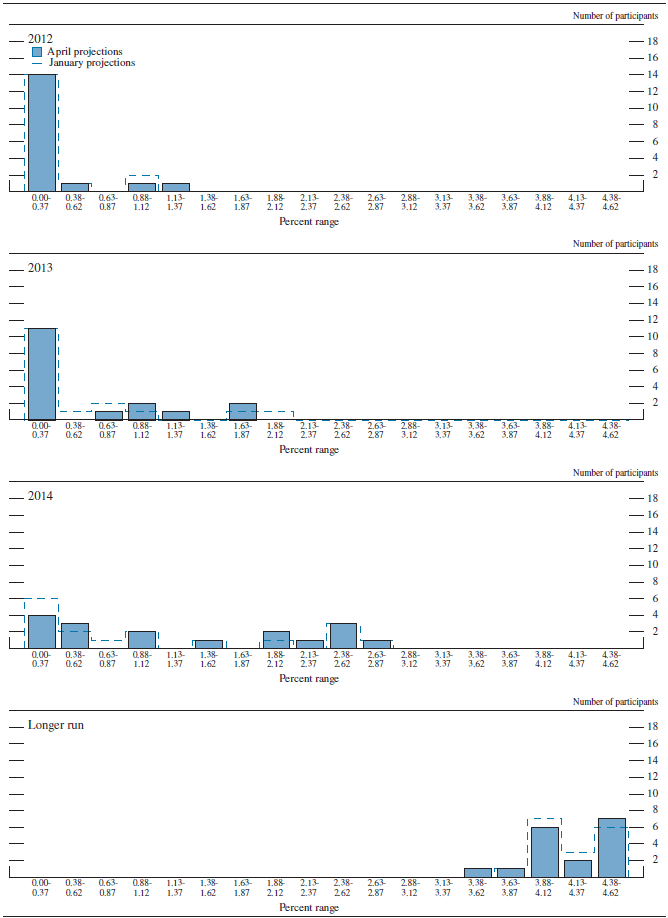
*NOTE: The target federal funds rate is measured as the level of the target rate at the end of the calendar year or in the longer run.
Accessible version of figure 3.E. | Return to figure 3.E.
Uncertainty and Risks
Most participants judged that their projections for real GDP growth and the unemployment rate were subject to a higher level of uncertainty than was the norm during the previous 20 years (figure 4).1 However, the number reporting elevated uncertainty moved down somewhat relative to the January SEP. Many participants also judged the levels of uncertainty associated with their inflation forecasts to be higher than the longer-run historical norm, but such an assessment continued to be somewhat less prevalent among participants than was the case for uncertainty about real activity. Several factors were said to be contributing to the elevated level of uncertainty about the economic outlook, including ongoing developments regarding the fiscal and financial situation in Europe. Many participants also cited considerable uncertainty about U.S. fiscal policy over coming quarters and its potential implications for economic activity. More broadly, participants again noted difficulties in projecting the path of the economic recovery because deep recessions brought on by severe financial crises differed importantly from most historical experience. In that regard, participants continued to be uncertain about the pace at which credit conditions would improve and about the prospects for recovery in the housing sector. In addition, participants generally saw the longer-term outlook for fiscal and regulatory policies as still highly uncertain. Some participants also expressed uncertainty about the extent to which the labor market was undergoing structural changes. Among the sources of uncertainty about the outlook for inflation were the difficulties in assessing the current and prospective margins of slack in resource markets and the effect of such slack on prices. Participants also cited uncertainty about the future path of global commodity prices, which were seen as depending on idiosyncratic supply and demand factors as well as on global growth.
Table 2. Average historical projection error ranges
Percentage points
| Variable | 2012 | 2013 | 2014 |
|---|---|---|---|
| Change in real GDP1 | ±1.1 | ±1.6 | ±1.7 |
| Unemployment rate1 | ±0.5 | ±1.2 | ±1.7 |
| Total consumer prices2 | ±0.8 | ±1.0 | ±1.0 |
Note: Error ranges shown are measured as plus or minus the root mean squared error of projections for 1991 through 2010 that were released in the winter by various private and government forecasters. As described in the box "Forecast Uncertainty," under certain assumptions, there is about a 70 percent probability that actual outcomes for real GDP, unemployment, and consumer prices will be in ranges implied by the average size of projection errors made in the past. Further information is in David Reifschneider and Peter Tulip (2007), "Gauging the Uncertainty of the Economic Outlook from Historical Forecasting Errors," Finance and Economics Discussion Series 2007-60 (Washington: Board of Governors of the Federal Reserve System, November).
1. For definitions, refer to general note in table 1. Return to table
2. Measure is the overall consumer price index, the price measure that has been most widely used in government and private economic forecasts. Projection is percent change, fourth quarter of the previous year to the fourth quarter of the year indicated. Return to table
Turning to the balance of risks that participants attached to their economic projections, about half reported that they judged the risks to their forecasts of both real GDP growth and the unemployment rate as broadly balanced, a few more than was the case in January. Nearly all of the remaining participants viewed the risks to real GDP growth as weighted to the downside and the risks to the unemployment rate as skewed to the upside. Participants identified several downside risks to the projected pace of economic expansion, including the fiscal and financial strains in the euro area and the possibility of an abrupt fiscal consolidation in the United States. In addition, some of the factors that had restrained the U.S. recovery in recent years could persist for longer than currently expected and thus weigh on economic activity to a greater extent going forward than participants had assumed in their baseline forecasts. In particular, some participants mentioned the downside risks to consumer spending in light of meager gains in disposable personal income and households' still-weak balance sheets. Others cited the possible damping effects of high levels of uncertainty regarding regulatory policies on businesses' willingness to invest and hire. A few participants noted the risk of another disruption in global oil markets or greater tensions in the Middle East that could not only boost inflation but also reduce real incomes, consumer confidence, and spending. Some of the participants who judged the risks to be broadly balanced recognized some of these downside risks to the outlook, but they saw them as about counterbalanced by the chance that the recent signs of improvement in labor markets and consumer spending could signal the emergence of a more vigorous recovery.
Most participants judged the risks to their projections of inflation as broadly balanced, including a few more than held that view in January. However, a few saw the risks as tilted to the upside, pointing to the possibility of disruptions in global oil and commodity markets or to effects from the current stance of monetary policy. Two of these participants indicated that the current highly accommodative stance of monetary policy and the substantial liquidity currently in the financial system risked a pickup in inflation to a level above the Committee's longer-run objective, or cited the risk that uncertainty about the Committee's ability to effectively remove policy accommodation when appropriate could lead to a rise in inflation expectations.
Figure 4. Uncertainty and risks in economic projections*
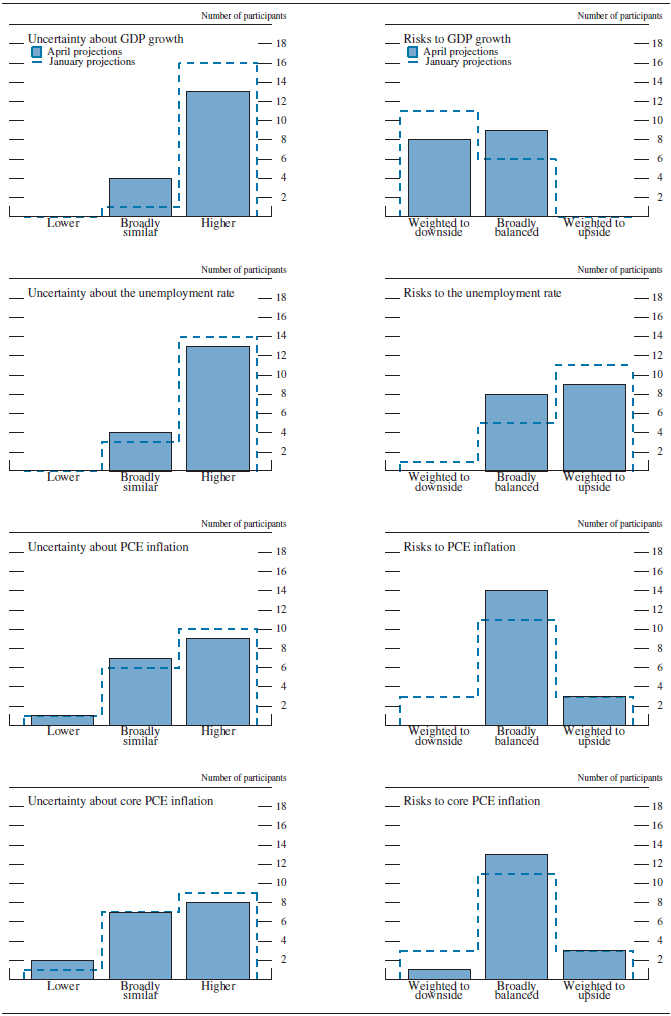
*NOTE: For definitions of uncertainty and risks in economic projections, see the box “Forecast Uncertainty.” Definitions of variables are in the general note to table 1.
Accessible version of figure 4 | Return to figure 4
The economic projections provided by the members of the Board of Governors and the presidents of the Federal Reserve Banks inform discussions of monetary policy among policymakers and can aid public understanding of the basis for policy actions. Considerable uncertainty attends these projections, however. The economic and statistical models and relationships used to help produce economic forecasts are necessarily imperfect descriptions of the real world, and the future path of the economy can be affected by myriad unforeseen developments and events. Thus, in setting the stance of monetary policy, participants consider not only what appears to be the most likely economic outcome as embodied in their projections, but also the range of alternative possibilities, the likelihood of their occurring, and the potential costs to the economy should they occur.
Table 2 summarizes the average historical accuracy of a range of forecasts, including those reported in past Monetary Policy Reports and those prepared by the Federal Reserve Board’s staff in advance of meetings of the Federal Open Market Committee. The projection error ranges shown in the table illustrate the considerable uncertainty associated with economic forecasts. For example, suppose a participant projects that real gross domestic product (GDP) and total consumer prices will rise steadily at annual rates of, respectively, 3 percent and 2 percent. If the uncertainty attending those projections is similar to that experienced in the past and the risks around the projections are broadly balanced, the numbers reported in table 2 would imply a probability of about 70 percent that actual GDP would expand within a range of 1.9 to 4.1 percent in the current year, 1.4 to 4.6 percent in the second year, and 1.3 to 4.7 percent in the third year. The corresponding 70 percent confidence intervals for overall inflation would be 1.2 to 2.8 percent in the current year and 1.0 to 3.0 percent in the second and third years.
Because current conditions may differ from those that prevailed, on average, over history, participants provide judgments as to whether the uncertainty attached to their projections of each variable is greater than, smaller than, or broadly similar to typical levels of forecast uncertainty in the past, as shown in table 2. Participants also provide judgments as to whether the risks to their projections are weighted to the upside, are weighted to the downside, or are broadly balanced. That is, participants judge whether each variable is more likely to be above or below their projections of the most likely outcome. These judgments about the uncertainty and the risks attending each participant’s projections are distinct from the diversity of participants’ views about the most likely outcomes. Forecast uncertainty is concerned with the risks associated with a particular projection rather than with divergences across a number of different projections.
As with real activity and inflation, the outlook for the future path of the federal funds rate is subject to considerable uncertainty. This uncertainty arises primarily because each participant’s assessment of the appropriate stance of monetary policy depends importantly on the evolution of real activity and inflation over time. If economic conditions evolve in an unexpected manner, then assessments of the appropriate setting of the federal funds rate would change from that point forward.
1. Table 2 provides estimates of the forecast uncertainty for the change in real GDP, the unemployment rate, and total consumer price inflation over the period from 1992 to 2011. At the end of this summary, the box "Forecast Uncertainty" discusses the sources and interpretation of uncertainty in the economic forecasts and explains the approach used to assess the uncertainty and risks attending the participants' projections. Return to text